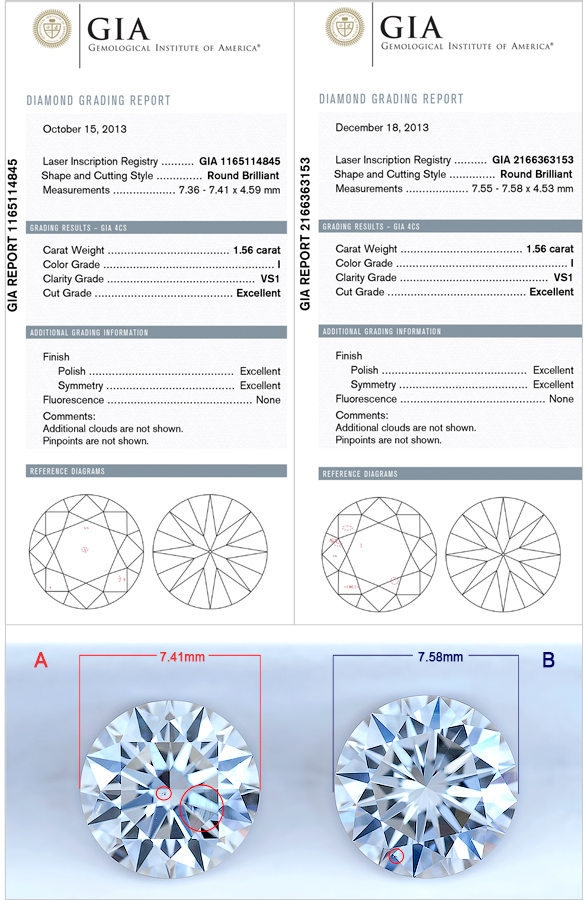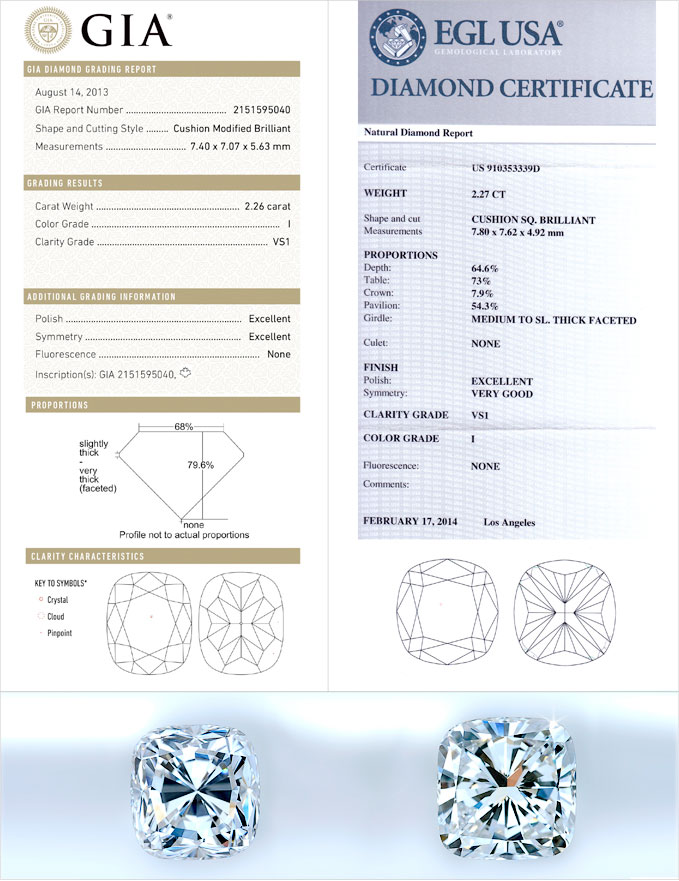How to Value a Diamond
The single most important piece of advice every diamond buyer should know:
Two diamonds with identical certificate grades are rarely equal in brilliance or value. It is unwise to purchase a diamond based upon certificate grades alone.
Example 1:
The two diamonds below have identical GIA certificates:
Color: I / Clarity: VS1 / Polish: Excellent / Symmetry: Excellent / Cut: Excellent
Why is diamond B approximately 20% more valuable than Diamond A?

1. Diamond ‘B’ has better proportion clearly evident in the larger ‘face size’.
Diameter Measurements: A = 7.41mm: B = 7.58mm:
2. Diamond ‘B’ is slightly whiter and more brilliant than ‘A’ even though both stones are graded GIA ‘I’ color.
It is not unusual for 2 diamonds with the same certified color grade to show color differently when viewed face up.
3. The inclusions in diamond ‘A’ are located in the center (circled) whereas in diamond ‘B’ the inclusions are smaller and located towards the outside edge [circled bottom left].
Diamond ‘B’ is a more valuable example of GIA, VS1 clarity grade.
At Ascot every diamond is scrutinized for brilliance, proportion and correct value before being added to our inventory and offered for sale; Less than 5% of all diamonds produced meet Ascot’s demanding standards.
Example 2:
In rare instances a diamond graded by the EGL USA may be more valuable than a GIA stone with the similar grades:
The 2 diamonds below have identical grades from the GIA and EGL USA:
Color: I / Clarity: VS1
We know GIA grades are stricter than EGL USA and therefore it would seem reasonable to assume that the GIA diamond is more valuable.
When we compare these 2 stones ‘side by side’ however, we see a different story unfold.

While the GIA stone on the left is whiter, it is also considerably smaller than the EGL US; The GIA diamond has been cut to maximize weight rather than ‘face size’ and brilliance.
The ‘face size’ on this GIA diamond is appropriate for a 1.75 carat rather than the 2.25 carat. Weight has been left on the underside of this diamond making the stone heavier but not larger where it matters [face size].
Based on this stone having GIA ‘Excellent – Polish and Symmetry’ grades, an unsuspecting buyer might assume this diamond is therefore desirable and beautiful? Could not be further from reality… This stone has significant value problems.
In contrast the EGL USA diamond on the right is beautifully cut, brilliant and has a face size that relates correctly to the carat weight.
A GIA certificate is no guarantee that a diamond is cut, graded or valued correctly. We advise diamond buyers to seek out a diamond company with an impeccable reputation, committed to offer only the most desirable diamonds, valued correctly.
We invite you to visit Ascot Diamonds in New York, Dallas, Washington DC, Atlanta or Charlotte where clients receive a priceless education in a dignified atmosphere and compare diamonds from ‘the most carefully selected diamond inventory in the world’.